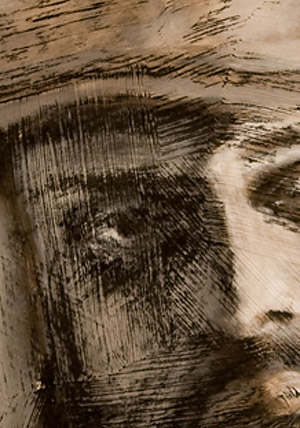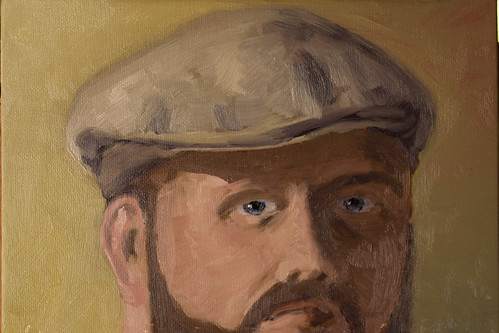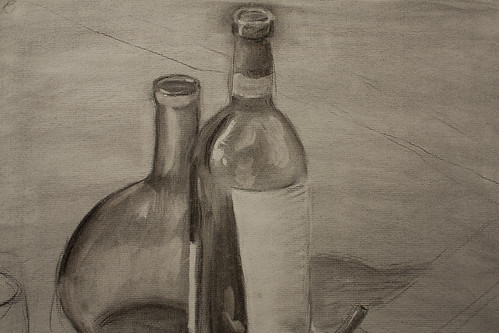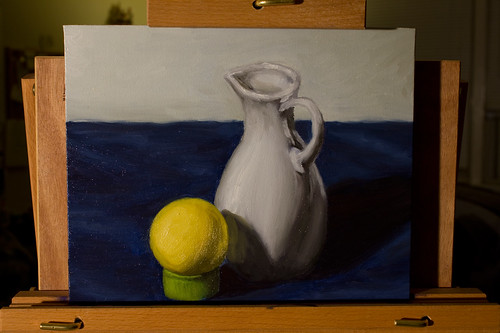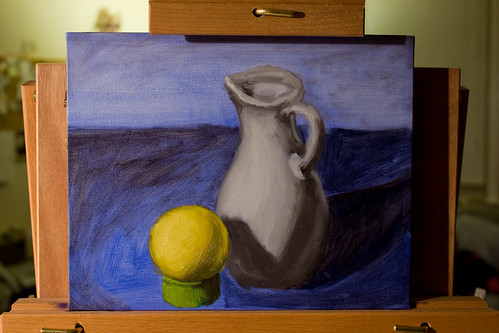For many months now, almost a year, I have been struggling more than I could see with a deep depression. I hid it from myself. I may have hidden it from my therapist, though I suspect he saw it all along. I went out of my way to hide it from the people I work and play with. I even tried to hide it from the people who love me.
I allowed life to lose all meaning. I stopped even trying, convincing myself that everything I did was fraud and that I would be found out at any minute. While I don't believe I have it in me to commit suicide, my thoughts were laden with the idea. I stopped sleeping a few months ago, when it became too frightening to turn out the light and put my head on a pillow. As soon as the world became dark and quiet, everything I had been hiding from during the day rushed in to fill up the space, every self-recrimination, every self-criticism, all the self-hatred and yes, those graphic imaginings of hurting myself. The only time I slept was when I was just too exhausted to stay awake any more, and then I would sleep for entire days. The quality of my life, and of the lives I touch, was diminished. Outwardly, I became withdrawn and detached. I would come home and pour over the headlines trying to convince myself I was interested in being involved. Sometimes I would just sit and beat myself relentlessly with frustration and anxiety. Inwardly I was obsessed and paranoid. Everything anyone did that wasn't exactly what I wanted them to do became a personal attack, in my mind. Everything anyone asked of me became stressful and repressive expectation. I wanted to become as small as possible and disappear forever. I wanted everything to just stop. I held myself back from these people who's only crime was caring about me. Advice and concern were scorned, and in some cases belittled, as I could not see how I was changing and blamed everyone else for things being different. Healing many of these relationships is going to take years of honesty and hard work. Some may be beyond repair. It is important for me to let these people know I was not of my right mind and do not hold them responsible for my troubles. I am greatly embarrassed for many of the things I said and did over this past year.
Some people in my life have been hurt, directly and indirectly, as a result of this.
The process of healing has begun, though stumbles are there in spades. Life is never clean and clinical, and it shouldn't be. The only way to live life is to do just that, live it and accept it for what it is, the only life we know. Even so, it will be tough to open myself up to a lot of it. I am not kind to myself. I don't like how I feel most of the time, and I fear connecting with new people. The pain involved in being a part of life can be overwhelming sometimes, and I have a tendency to avoid exposing myself to the possibility of pain repeated. Risk is something I will have to work very hard to integrate into my work. Risk will likely be profoundly difficult, maybe sometimes impossible, to allow back into my personal life.
The many weeks it has taken me to say, "I'm working again," have been filled with fears and learning and work and even humiliation. It took a lot to finally admit to myself, to my therapist, to my doctor, my boss, my friends, my family that I had lost control, that I had been wallowing in self-pity and self-neglect, that I was in a dark hole and I no longer knew which way was up. I have stopped digging, and taken some steps to climb back out.
The most important aspect of this has been the understanding and support of the people in my life. I understand that I regularly try their patience, and probably infuriate them. I have been fortunate to have loving, caring people when I finally started opening to them. Taking steps to smash through the walls I built and giving up the pretense that I was okay as I was would be pointless and nearly impossible without them. I am grateful, every day now, for the people I have been fortunate enough to know, love, and/or be related to.
Another major key for me has been facing the challenge of making meaning in my own life. For years I have understood that there is no meaning inherent in the Universe, no grand plan for each of us in this life. There is no shepherd to guide us along when we lose our way. When I was younger, I couldn't see the implications of this understanding. When I was in school and working as a commercial artist, meaning in my work was dictated by instructors and clients. When I turned my back on art, meaning had little place for me, even though I strove and struggled with my big picture of the universe. I did not understand what role meaning had in my life until I tried to create authentically, from my own heart and mind. Only now do I begin to understand how profound a lack of meaning can be. It took losing myself and losing the most beautiful thing ever for me to see how meaning effects my life. We have to be our own shepherd. Each of us, at least those of us for whom meaning is essential, must choose for ourselves what life will mean. We must accept responsibility for deciding what worthy work is, what each moment of life will mean, and what ethos we choose to live by. This idea of the artist as meaning-maker, as well as a great understanding of the roles anxiety and depression play in acts of creation, is fleshed out quite well in two books by Eric Maisel, PhD. (interview, another) I have been reading and working with my therapist through The Van Gogh Blues and Fearless Creating. These two books have been a tremendous help in finding my way out of the dark. If you are struggling with depression, or trying to figure out how to be creative, or frozen by your existential anxieties, I can not recommend these books strongly enough. They may not be for you. I have a bent toward psychological discussions and existential frustrations that made the language in these books click for me like nothing else. I have found a lot of help and understanding presented in those pages.
I started to open my mind up to forms of art that I never cared for. In the process I have begun to understand the work of a few artists I never thought held meaning for me. On a trip to the Philadelphia Museum of Art, I saw paintings by Giacometti. I was familiar with his sculptures, but they said little to me. His paintings, particularly his portraits, move me more than I expected. I didn't even know he painted. I was also exposed to some earlier works by Piet Mondrian that I was unaware of. I think I have fallen in love with trees all over again. Even his later "compositions" that used to just annoy me make some sense now.
I'm not sure I understand it, but I am irresistibly drawn to the work of Roberto Matta. Not everything he did appeals, but the majority of his paintings grab a hold of me and shake, and not in an entirely unpleasant way.
On a trip to the National Gallery of Art I was re-connected with my love of the great painters throughout history. For the second time in my life, I was face-to-face (so to speak) with a Rembrandt self portrait. Previously, I had only seen one work by Rembrandt in person, and that was a large self portrait in the Frick Collection, in New York City. Part of what started me on the art path so many years ago was my fascination with and appreciation for Rembrandt's work. It is very moving to me to view the power and beauty held in a single master's brush stroke. Many others among my favorite artists are also represented at the National Gallery, including my favorite John Sloan painting. The time spent in the galleries was blissful.
I even started to play golf again, despite a rather nasty set of spinal injuries. Those days in the Sun, among my friends, are a great healing salve. I'm not keeping score this year, and I'm trying not to count the balls I've lost. The occasional great shot (I had a pitch-in from 25 yards!) makes the game a success, and the physical activity and camaraderie are impossible to put a price on.
I don't have much to share as far as the work goes, for now. I stopped trying to force myself to paint in oils. I have not given up the desire, but I was making the whole medium out to be far more difficult than it needs to be. I made a mountain out of it that I just could not climb, then I beat myself up about it with each failure to the point that I stopped trying altogether and remained immobile for months. The ideas and work that I am pursuing may not be for public consumption, though I promise to share anything I find worth showing, and maybe force myself to show things I have doubts about. The subjects for now are emotions and facial expression. I have an overwhelming image in my head, and have for some time, of the frustration and rage and fear and anxiety and depression and loss I have known. It may be realized, and this series of pictures I'm working on will likely be the vehicle if it is. I have limited my materials to compressed charcoal, paint thinner, and gesso, for the time-being. I already have visions of colors involved, so it will not be monochromatic work for long. There is ample room to explore pastels in the mix or even acrylic paints... who knows? I am trying to invent technique through experiment and purpose. While I know others have worked with these tools, I took my only influence from a couple of images and a short paragraph roughly describing one artist's methods.
I don't really want to say more about the work just now. I have a long way to go, and much healing to attend to. I wish very much to dedicate some time to keeping this blog moving. I thought it was going somewhere once, and would like to see it become a place to share and maybe even connect with some folks. Solitude is fine for work time, but I can not keep myself locked in my apartment anymore. It is time to live again and grow as a person, and as an artist.
